
Concept explainers
In Example 2.6, we considered a simple model for a rocket launched from the surface of the Earth. A better expression for the rocket’s position measured from the center of the Earth is given by
where
a. Derive expressions for
b. Plot y(t), vy(t), and ay(t). (A spreadsheet program would be helpful.)
c. When will the rocket be at
d. What are
(a)
The expressions for
Answer to Problem 46PQ
The expression for
Explanation of Solution
Write the given expression for the position vector.
Here,
Velocity is the time derivative of position vector. Write the equation for velocity.
Here,
Acceleration is the time derivative of velocity. Write the expression for acceleration.
Here,
Conclusion:
Put equation (I) in equation (II).
Put equation (IV) in equation (III).
Therefore, the expression for
(b)
Plots of
Answer to Problem 46PQ
The plot of
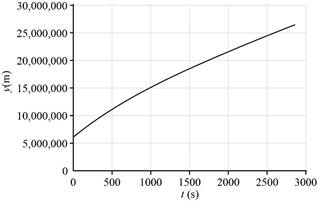
The plot of
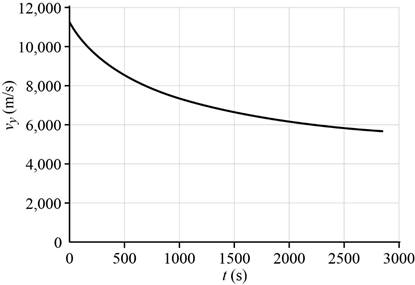
And the plot of
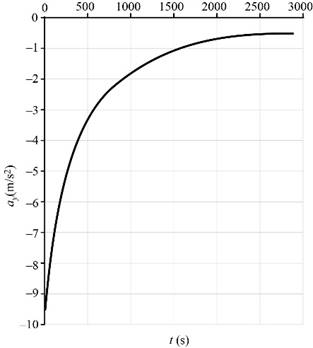
Explanation of Solution
The graph of position versus time of an object gives the position of the object at different instant of time. The slope of the position versus time graph gives the magnitude of the velocity of the object. In velocity versus time graph of an object, its velocity at different instants of time is plotted. The slope of this graph gives the magnitude of acceleration of the object. In acceleration versus time graph, acceleration is plotted as a function of time.
The plot of

The plot of
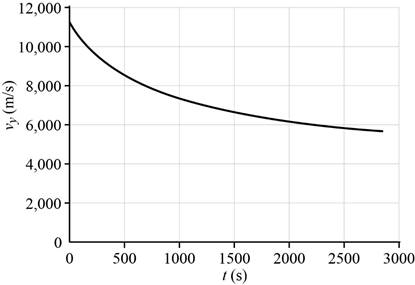
From the figure it is clear that the rocket has maximum velocity when it starts its motion and the velocity decreases with time. The graph has negative slope implying the acceleration is negative.
The plot of
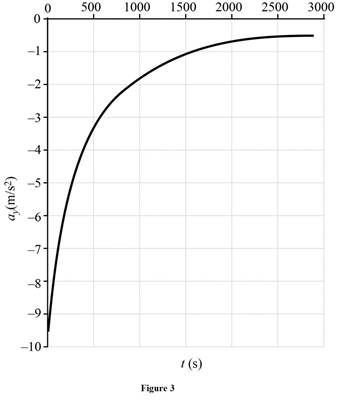
From the figure, it is clear that the rocket has negative acceleration.
(c)
The time at which the rocket will be at
Answer to Problem 46PQ
The time at which the rocket will be at
Explanation of Solution
Equation (I) can be used to determine the time at which the rocket will be at
Substitute
Take the power
Conclusion:
Given that the radius of the Earth is
Substitute
Therefore, the time at which the rocket will be at
(d)
The value of
Answer to Problem 46PQ
The value of
Explanation of Solution
Equation (IV) can be used to determine the value of
Conclusion:
Substitute
Substitute
Therefore, the value of
Want to see more full solutions like this?
Chapter 2 Solutions
Physics for Scientists and Engineers: Foundations and Connections
- A skier of mass 75 kg is pulled up a slope by a motor-driven cable. (a) How much work is required to pull him 50 m up a 30° slope (assumed frictionless) at a constant speed of 2.8 m/s? KJ (b) What power (expressed in hp) must a motor have to perform this task? hparrow_forwardA block of mass 1.4 kg is attached to a horizontal spring that has a force constant 900 N/m as shown in the figure below. The spring is compressed 2.0 cm and is then released from rest. a x = 0 x b (a) A constant friction force of 4.4 N retards the block's motion from the moment it is released. Using an energy approach, find the position x of the block at which its speed is a maximum. cm (b) Explore the effect of an increased friction force of 13.0 N. At what position of the block does its maximum speed occur in this situation? cmarrow_forwardA block of mass m = 3.00 kg situated on a rough incline at an angle of 0 = 37.0° is connected to a spring of negligible mass having a spring constant of 100 N/m (see the figure below). The pulley is frictionelss. The block is released from rest when the spring is unstretched. The block moves 11.0 cm down the incline before coming to rest. Find the coefficient of kinetic friction between block and incline. k=100 N/m Ө marrow_forward
- 23. What is the velocity of a beam of electrons that goes undeflected when passing through perpendicular electric and magnetic fields of magnitude 8.8 X 103 V/m and 7.5 X 10-3 T. respectively? What is the radius of the electron orbit if the electric field is turned off?arrow_forward10. A light bulb emits 25.00 W of power as visible light. What are the average electric and magnetic fields from the light at a distance of 2.0 m?arrow_forward9. Some 1800 years ago Roman soldiers effectively used slings as deadly weapons. The length of these slings averaged about 81 cm and the lead shot that they used weighed about 30 grams. If in the wind up to a release, the shot rotated around the Roman slinger with a period of .15 seconds. Find the maximum acceleration of the shot before being released in m/s^2 and report it to two significant figures.arrow_forward
- In the movie Fast X, a 10100 kg round bomb is set rolling in Rome. The bomb gets up to 17.6 m/s. To try to stop the bomb, the protagonist Dom swings the counterweight of a crane, which has a mass of 354000 kg into the bomb at 3.61 m/s in the opposite direction. Directly after the collision the crane counterweight continues in the same direction it was going at 2.13 m/s. What is the velocity (magnitude and direction) of the bomb right after the collision?arrow_forwardDon't use aiarrow_forwardMake sure to draw a sketch with scale pleasearrow_forward
 Principles of Physics: A Calculus-Based TextPhysicsISBN:9781133104261Author:Raymond A. Serway, John W. JewettPublisher:Cengage Learning
Principles of Physics: A Calculus-Based TextPhysicsISBN:9781133104261Author:Raymond A. Serway, John W. JewettPublisher:Cengage Learning College PhysicsPhysicsISBN:9781285737027Author:Raymond A. Serway, Chris VuillePublisher:Cengage Learning
College PhysicsPhysicsISBN:9781285737027Author:Raymond A. Serway, Chris VuillePublisher:Cengage Learning Physics for Scientists and Engineers, Technology ...PhysicsISBN:9781305116399Author:Raymond A. Serway, John W. JewettPublisher:Cengage Learning
Physics for Scientists and Engineers, Technology ...PhysicsISBN:9781305116399Author:Raymond A. Serway, John W. JewettPublisher:Cengage Learning Physics for Scientists and EngineersPhysicsISBN:9781337553278Author:Raymond A. Serway, John W. JewettPublisher:Cengage Learning
Physics for Scientists and EngineersPhysicsISBN:9781337553278Author:Raymond A. Serway, John W. JewettPublisher:Cengage Learning Physics for Scientists and Engineers with Modern ...PhysicsISBN:9781337553292Author:Raymond A. Serway, John W. JewettPublisher:Cengage Learning
Physics for Scientists and Engineers with Modern ...PhysicsISBN:9781337553292Author:Raymond A. Serway, John W. JewettPublisher:Cengage Learning University Physics Volume 1PhysicsISBN:9781938168277Author:William Moebs, Samuel J. Ling, Jeff SannyPublisher:OpenStax - Rice University
University Physics Volume 1PhysicsISBN:9781938168277Author:William Moebs, Samuel J. Ling, Jeff SannyPublisher:OpenStax - Rice University





